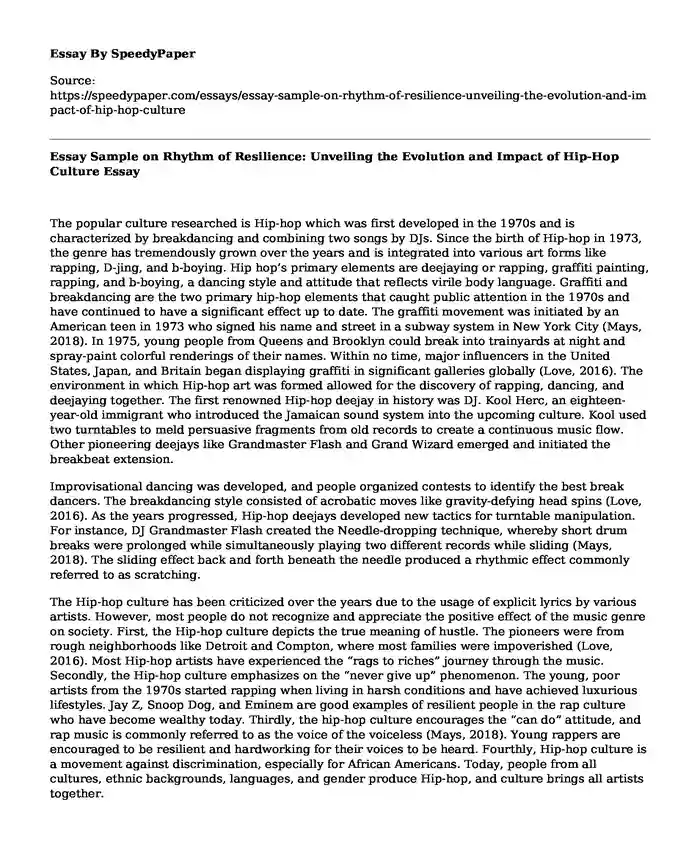The popular culture researched is Hip-hop which was first developed in the 1970s and is characterized by breakdancing and combining two songs by DJs. Since the birth of Hip-hop in 1973, the genre has tremendously grown over the years and is integrated into various art forms like rapping, D-jing, and b-boying. Hip hop’s primary elements are deejaying or rapping, graffiti painting, rapping, and b-boying, a dancing style and attitude that reflects virile body language. Graffiti and breakdancing are the two primary hip-hop elements that caught public attention in the 1970s and have continued to have a significant effect up to date. The graffiti movement was initiated by an American teen in 1973 who signed his name and street in a subway system in New York City (Mays, 2018). In 1975, young people from Queens and Brooklyn could break into trainyards at night and spray-paint colorful renderings of their names. Within no time, major influencers in the United States, Japan, and Britain began displaying graffiti in significant galleries globally (Love, 2016). The environment in which Hip-hop art was formed allowed for the discovery of rapping, dancing, and deejaying together. The first renowned Hip-hop deejay in history was DJ. Kool Herc, an eighteen-year-old immigrant who introduced the Jamaican sound system into the upcoming culture. Kool used two turntables to meld persuasive fragments from old records to create a continuous music flow. Other pioneering deejays like Grandmaster Flash and Grand Wizard emerged and initiated the breakbeat extension.
Improvisational dancing was developed, and people organized contests to identify the best break dancers. The breakdancing style consisted of acrobatic moves like gravity-defying head spins (Love, 2016). As the years progressed, Hip-hop deejays developed new tactics for turntable manipulation. For instance, DJ Grandmaster Flash created the Needle-dropping technique, whereby short drum breaks were prolonged while simultaneously playing two different records while sliding (Mays, 2018). The sliding effect back and forth beneath the needle produced a rhythmic effect commonly referred to as scratching.
The Hip-hop culture has been criticized over the years due to the usage of explicit lyrics by various artists. However, most people do not recognize and appreciate the positive effect of the music genre on society. First, the Hip-hop culture depicts the true meaning of hustle. The pioneers were from rough neighborhoods like Detroit and Compton, where most families were impoverished (Love, 2016). Most Hip-hop artists have experienced the “rags to riches” journey through the music. Secondly, the Hip-hop culture emphasizes on the “never give up” phenomenon. The young, poor artists from the 1970s started rapping when living in harsh conditions and have achieved luxurious lifestyles. Jay Z, Snoop Dog, and Eminem are good examples of resilient people in the rap culture who have become wealthy today. Thirdly, the hip-hop culture encourages the “can do” attitude, and rap music is commonly referred to as the voice of the voiceless (Mays, 2018). Young rappers are encouraged to be resilient and hardworking for their voices to be heard. Fourthly, Hip-hop culture is a movement against discrimination, especially for African Americans. Today, people from all cultures, ethnic backgrounds, languages, and gender produce Hip-hop, and culture brings all artists together.
The Hip-hop culture fits in the definition of a subculture since it is a society with a group of people who maintain its founding principles. The Hip-hop culture has its defined values and norms regarding aspects like discrimination and cultural matters.
References
Love, B. L. (2016). Complex personhood of hip hop & the sensibilities of the culture that fosters knowledge of self & self-determination. Equity & Excellence in Education, 49(4), 414-427.
Mays, K. T. (2018). Hip hop beats, indigenous rhymes: Modernity and hip hop in indigenous North America. SUNY Press.
Cite this page
Essay Sample on Rhythm of Resilience: Unveiling the Evolution and Impact of Hip-Hop Culture. (2023, Dec 22). Retrieved from https://speedypaper.net/essays/essay-sample-on-rhythm-of-resilience-unveiling-the-evolution-and-impact-of-hip-hop-culture
Request Removal
If you are the original author of this essay and no longer wish to have it published on the SpeedyPaper website, please click below to request its removal:
- Learn about Cross Cultural Experience from Our Free Essay
- Free Essay Example: Win an Inn
- Essay Sample on the Play The Dog in the Manger
- Essay Sample about Nike's Hypocrisy in Supporting Colin Kaepernick's
- Free Essay on Organization and Unit Mission, Vision and Values; Shared Governance
- Free Essay. Comparison Between the Approaches of the Photorealists to That of Pop Artists
- Assessment Completion and Review of Assessment Constructs - Essay Sample
Popular categories





